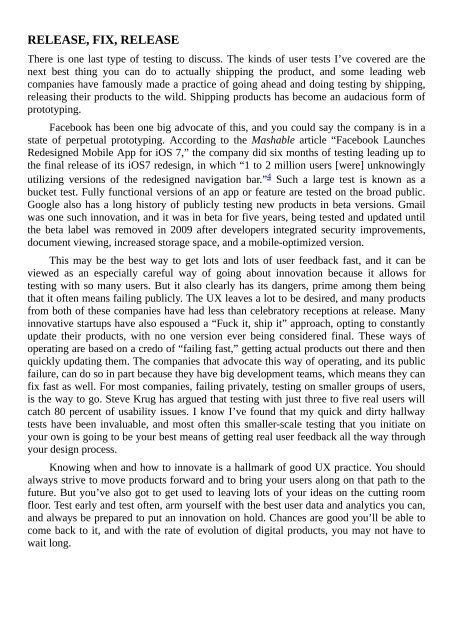Create successful ePaper yourself
Turn your PDF publications into a flip-book with our unique Google optimized e-Paper software.
RELEASE, FIX, RELEASE<br />
There is one last type of testing to discuss. The kinds of user tests I’ve covered are the<br />
next best thing you can do to actually shipping the product, and some leading web<br />
companies have famously made a practice of going ahead and doing testing by shipping,<br />
releasing their products to the wild. Shipping products has become an audacious form of<br />
prototyping.<br />
Facebook has been one big advocate of this, and you could say the company is in a<br />
state of perpetual prototyping. According to the Mashable article “Facebook Launches<br />
Redesigned Mobile App for iOS 7,” the company did six months of testing leading up to<br />
the final release of its iOS7 redesign, in which “1 to 2 million users [were] unknowingly<br />
utilizing versions of the redesigned navigation bar.” 4 Such a large test is known as a<br />
bucket test. Fully functional versions of an app or feature are tested on the broad public.<br />
Google also has a long history of publicly testing new products in beta versions. Gmail<br />
was one such innovation, and it was in beta for five years, being tested and updated until<br />
the beta label was removed in 2009 after developers integrated security improvements,<br />
document viewing, increased storage space, and a mobile-optimized version.<br />
This may be the best way to get lots and lots of user feedback fast, and it can be<br />
viewed as an especially careful way of going about innovation because it allows for<br />
testing with so many users. But it also clearly has its dangers, prime among them being<br />
that it often means failing publicly. The UX leaves a lot to be desired, and many products<br />
from both of these companies have had less than celebratory receptions at release. Many<br />
innovative startups have also espoused a “Fuck it, ship it” approach, opting to constantly<br />
update their products, with no one version ever being considered final. These ways of<br />
operating are based on a credo of “failing fast,” getting actual products out there and then<br />
quickly updating them. The companies that advocate this way of operating, and its public<br />
failure, can do so in part because they have big development teams, which means they can<br />
fix fast as well. For most companies, failing privately, testing on smaller groups of users,<br />
is the way to go. Steve Krug has argued that testing with just three to five real users will<br />
catch 80 percent of usability issues. I know I’ve found that my quick and dirty hallway<br />
tests have been invaluable, and most often this smaller-scale testing that you initiate on<br />
your own is going to be your best means of getting real user feedback all the way through<br />
your design process.<br />
Knowing when and how to innovate is a hallmark of good UX practice. You should<br />
always strive to move products forward and to bring your users along on that path to the<br />
future. But you’ve also got to get used to leaving lots of your ideas on the cutting room<br />
floor. Test early and test often, arm yourself with the best user data and analytics you can,<br />
and always be prepared to put an innovation on hold. Chances are good you’ll be able to<br />
come back to it, and with the rate of evolution of digital products, you may not have to<br />
wait long.


